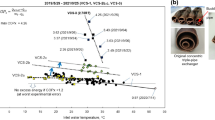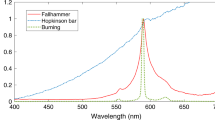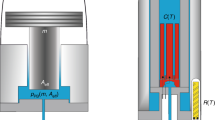Abstract
IN recent work on the explosive decomposition of gaseous diethyl peroxide, we detected transient temperature rises accompanying the admission of gases into an evacuated vessel. The experimental arrangement1 consisted essentially of a thermostated spherical vessel (1,222 ml.) fitted with a pressure transducer and a very fine thermocouple (0.0005 inch diameter platinum/platinum−13 per cent rhodium) which could be moved along the vertical diameter of the vessel. Gases were admitted to the evacuated vessel through an electromagnetic valve which was opened for a pre-set time interval (0.1 to 1.0 s). The pressure and temperature histories were displayed on an oscilloscope and photographed. Experiments revealed that when a complex species like diethyl ether was admitted to the hot evacuated vessel, the thermocouple registered small but significant temperature rises (up to 8° C above that of the vessel) even though the gas was initially 165° C cooler than the vessel. A systematic study with eighteen other gases of different mole-cularity showed that simple gases (high γ, low Cv) heated up dramatically on admission to the evacuated vessel (see Fig. 1). For example, when argon was admitted to the hot vessel (at 190° C) to give a final pressure of 10 mm mercury, the gas temperature rose to 275° C and, with 80 mm mercury pressure of argon in the same conditions, the gas temperature rose to 415° C.
This is a preview of subscription content, access via your institution
Access options
Subscribe to this journal
Receive 51 print issues and online access
$199.00 per year
only $3.90 per issue
Buy this article
- Purchase on Springer Link
- Instant access to full article PDF
Prices may be subject to local taxes which are calculated during checkout
Similar content being viewed by others
References
Fine, D. H., Gray, P., and MacKinven, R. . (in the press).
Melville, H. W., and Gowenlock, B. G., Experimental Methods in Gas Reactions, 403 (Macmillan, London, 1964).
Fine, D. H., Gray, P., and MacKinven, R., Twelfth Intern. Symp. on Combustion (The Combustion Institute, Pittsburgh, 1969, in the press).
Frank-Kamenetsky, D. A., (trans. by Thon, N.), Diffusion and Heat Exchange in Chemical Kinetics, chaps. 6 and 7 (Princeton University Press, 1955).
Kaufman, F., and Gerri, N. J., Eighth Intern. Symp. on Combustion, 619 (Williams and Wilkins, Baltimore, 1962).
Author information
Authors and Affiliations
Rights and permissions
About this article
Cite this article
FINE, D., GRAY, P. & MACKINVEN, R. Some Consequences of the Rapid Admission of Gas to an Evacuated Vessel. Nature 223, 393–394 (1969). https://doi.org/10.1038/223393a0
Received:
Issue Date:
DOI: https://doi.org/10.1038/223393a0
Comments
By submitting a comment you agree to abide by our Terms and Community Guidelines. If you find something abusive or that does not comply with our terms or guidelines please flag it as inappropriate.



